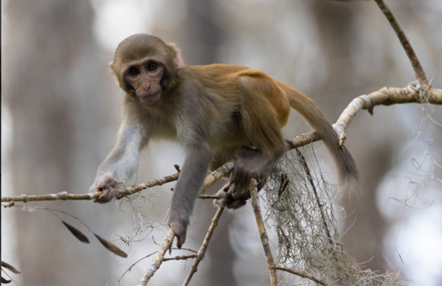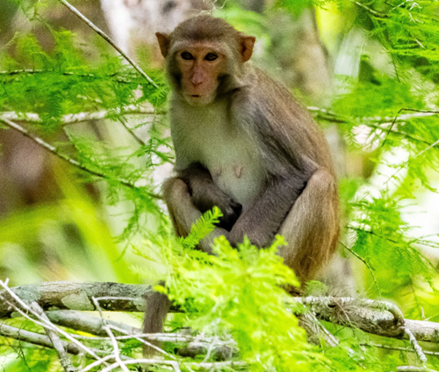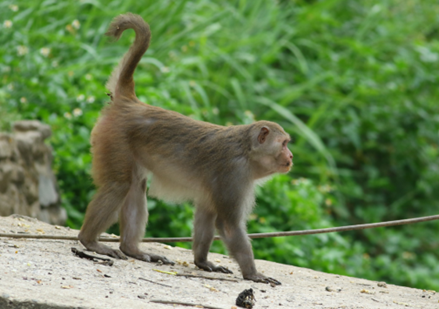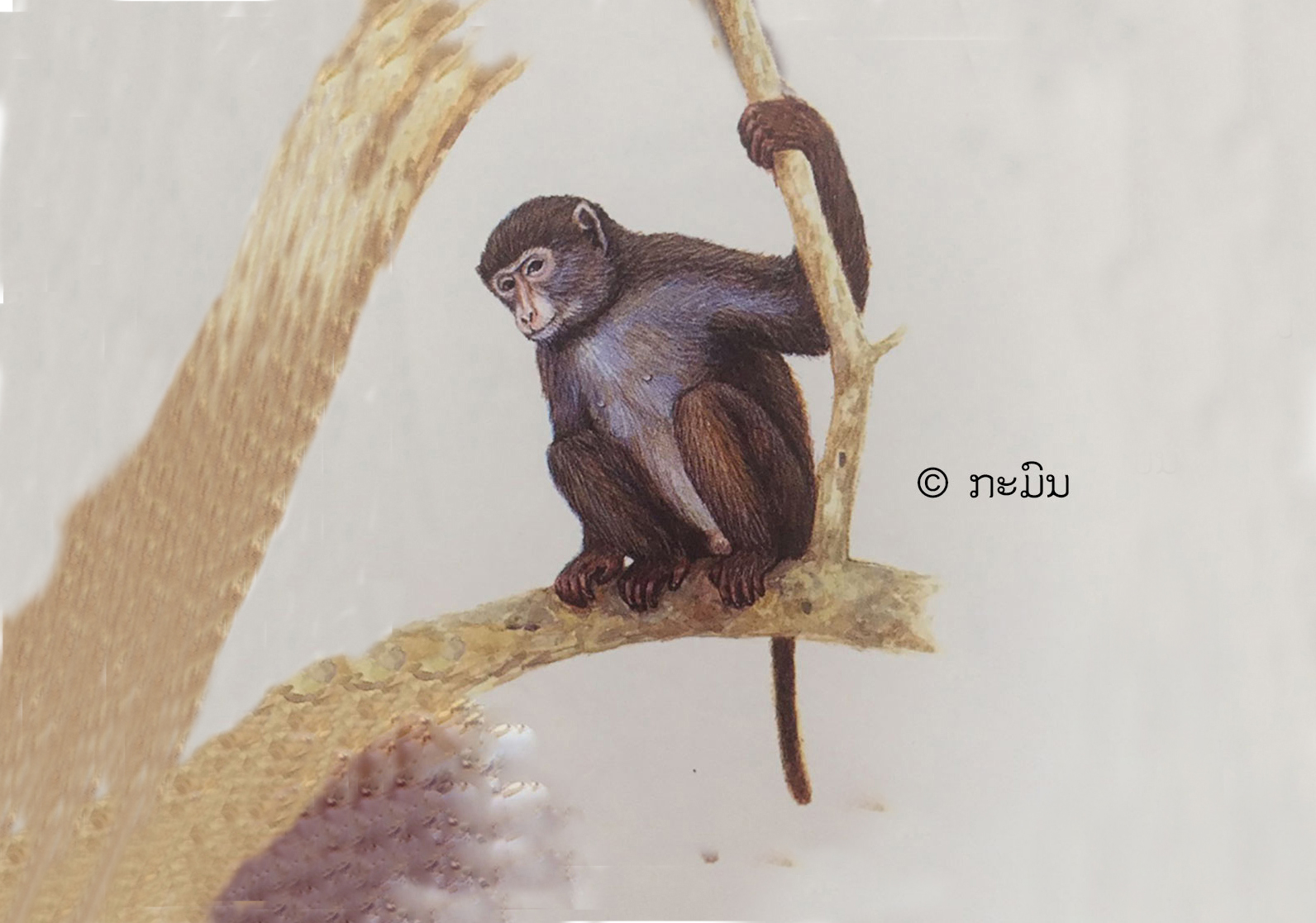ເລກລຳດັບທີ: 3585
ລະດັບການຮວບຮວມຂໍ້ມູນ: ຂໍ້ມູນພື້ນຖານ
ປັບປູງຄັ້ງລ່າສຸດ: 2024-10-19
ລີງວອກ
Rhesus Macaque
Macaca mulatta (Zimmermann, 1780)
ສັດ
ສັດລ້ຽງລູກດ້ວຍນົມ
×
ຊື່ທ້ອງຖີ່ນ:
ລີງແດງ, ອີ່ວອກ ( Rhesus Monkey)
ຊື່ພ້ອງ
:
Cercopithecus mulatta Zimmermann, 1780
Inuus sanctijohannis Swinhoe, 1866
Macaca brachyurus (Elliot, 1909)
Macaca brevicaudatus (Elliot, 1913)
Macaca erythraea (Shaw, 1800)
Macaca fulvus (Kerr, 1792)
Macaca lasiotus (Gray, 1868)
Macaca littoralis (Elliot, 1909)
Macaca mcmahoni Pocock, 1932
Macaca mulatta subsp. mcmahoni Pocock, 1932
Macaca nipalensis Hodgson, 1840
Inuus sanctijohannis Swinhoe, 1866
Macaca brachyurus (Elliot, 1909)
Macaca brevicaudatus (Elliot, 1913)
Macaca erythraea (Shaw, 1800)
Macaca fulvus (Kerr, 1792)
Macaca lasiotus (Gray, 1868)
Macaca littoralis (Elliot, 1909)
Macaca mcmahoni Pocock, 1932
Macaca mulatta subsp. mcmahoni Pocock, 1932
Macaca nipalensis Hodgson, 1840
ຊື່ສະກຸນ:
Cercopithecidae
ຊະນິດໃກ້ຄຽງ:
ລີງກັງ/ Pig-tailed Macaque
ລີງເສນ/ Stump-tailed Macaque
ລີງຫາງຍາວ/ Long-tailed Macaque
ລີງຜົມແບ່ງ/ Assamese Macaque
ລີງເສນ/ Stump-tailed Macaque
ລີງຫາງຍາວ/ Long-tailed Macaque
ລີງຜົມແບ່ງ/ Assamese Macaque
ບັນຍາຍລັກສະນະທາງພືດສາດ:
ຫົວ ແລະ ລຳຕົວຍາວ: 47-58 ຊມ, ຫາງຍາວ: 20-28 ຊມ. ເປັນລີງມີທາງຢ່ອນລົງທີ່ມີຄວາມຍາວເທົ່າກັບເຄິ່ງໜຶ່ງຂອງລໍາໂຕ, ມີລັກສະນະອອກສີແດງ, ຢູ່ໜຶ່ງ ສ່ວນສີ່ຂອງລໍາໂຕທາງດ້ານຫຼັງ ແລະ ມີລັກສະນະໂດດເດັ່ນເປັນສີແດງແຈ້ງຢູ່ທີ່ສ່ວນໂຄ້ງຂອງກົກຂາເຊິ່ງຈະ ເຫັນແຈ້ງໃນເວລາພົບຢູ່ໃນພາກສະໜາມ, ສ່ວນຢູ່ໃນລີງຜົມແບ່ງນັ້ນຢູ່ ໃນໜຶ່ງສ່ວນສີ່ຂອງລໍາໂຕດ້ານຫລັງຈະເປັນສີມົ່ນ ຫຼື ສີນໍ້າຕານ, ມີຂົນສັ້ນຢູ່ເທິງຫົວ ແລະ ບໍ່ມີຮອຍແບ່ງລະຫວ່າງກາງ, ມັນມີລັກສະນະພິເສດ ຢູ່ທາງຫົວດ້ານໜ້າທີ່ມີສີເຂັ້ມກວ່າ, ລັກສະນະນີ້ຈະບໍ່ເດັ່ນຄືລີງກັງ ແລະ ມີຂົນແຍກດ້ານຂ້າງໜ້ອຍ.
ອຸປະນິໄສ: ເປັນສັດຫາກິນກາງເວັນ ສ່ວນຫຼາຍຫາກິນຢູ່ເທິງໜ້າດິນ ແລະ ບາງສ່ວນຈະຢູ່ຕາມຕົ້ນໄມ້. ມັນຢູ່ຮ່ວມກັນເປັນຝູງໃຫຍ່, ບາງ ເທື່ອຈະມີຫຼາຍກ່ວາຫ້າສິບໂຕ.
ສຽງຮ້ອງ: ?
ຖິ່ນອາໄສ: ປ່າດົງດິບໂດຍສະເພາະໃນເຂດທີ່ຕໍ່າກັບປ່າເສື່ອມໂຊມ ແລະ ຕາມແຄມແມ່ນໍ້າ, ປົກກະຕິຈະຢູ່ສູງກວ່າລະດັບນ້ຳທະເລ 600 ມ.
ອຸປະນິໄສ: ເປັນສັດຫາກິນກາງເວັນ ສ່ວນຫຼາຍຫາກິນຢູ່ເທິງໜ້າດິນ ແລະ ບາງສ່ວນຈະຢູ່ຕາມຕົ້ນໄມ້. ມັນຢູ່ຮ່ວມກັນເປັນຝູງໃຫຍ່, ບາງ ເທື່ອຈະມີຫຼາຍກ່ວາຫ້າສິບໂຕ.
ສຽງຮ້ອງ: ?
ຖິ່ນອາໄສ: ປ່າດົງດິບໂດຍສະເພາະໃນເຂດທີ່ຕໍ່າກັບປ່າເສື່ອມໂຊມ ແລະ ຕາມແຄມແມ່ນໍ້າ, ປົກກະຕິຈະຢູ່ສູງກວ່າລະດັບນ້ຳທະເລ 600 ມ.
ນິເວດວິທະຍາ
ເຂດກະຈາຍພັນທົ່ວໂລກ:
Native to Afghanistan ,Bangladesh, Bhutan; China, India, Laos Myanmar, Nepal, Pakistan, Thailand and Viet Nam
Source: [7]
Source: [7]
ເຂດກະຈາຍພັນໃນລາວ
:
ເຂດພູສູງສາຍພູຫຼວງ ແລະ ເຂດພູພຽງແຂວງຊຽງຂວາງ
ເຂດສາຍພູຫຼວງພາກເໜືອ
ເຂດລຽບແມ່ນ້ຳຂອງພາກໃຕ້
ເຂດສາຍພູຫຼວງພາກເໜືອ
ເຂດລຽບແມ່ນ້ຳຂອງພາກໃຕ້

ເຂດກະຈາຍພັນຕາມພູມສັນຖານ
:
ປ່າປະສົມປ່ຽນໃບ
ປ່າແປກປະສົມປ່າໃບກ້ວາງ
ປ່າປູກ
ປ່າໄມ້ປ່ອງ
ປ່າແປກປະສົມປ່າໃບກ້ວາງ
ປ່າປູກ
ປ່າໄມ້ປ່ອງ
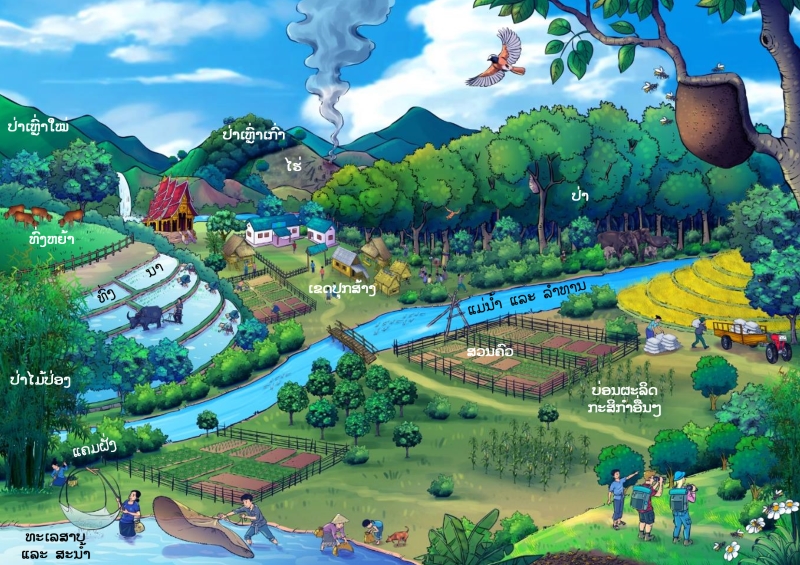
ສະເພາະຖິ່ນໃນລາວ:
ພື້ນເມືອງ
ຮຸກຮານ
:
ບໍ່ຮຸກຮານ
ສະຖານະພາບການອະນູຮັກ IUCN
:
ມີຄວາມສ່ຽງໜ້ອຍສຸດ
ສະຖານະພາບການອະນຸຮັກແຫ່ງຊາດລາວ
:
ບັນຊີທີ່ I: ຊະນິດພັນປະເພດຫວງຫ້າມ
ການນຳໃຊ້
ປະເພດການນຳໃຊ້:
ຫ້າມນຳໃຊ້
ບັນຍາຍການນຳໃຊ້:
ການປູກ ການລ້ຽງ:
ຊະນິດທຳມະຊາດ
ລະດູການເກັບກູ້:
ການຕະຫຼາດ ແລະ ຕ່ອງໂສ້ມູນຄ່າ:
N/A
ການຄຸ້ມຄອງຈັດການ
N/A
ໂພຊະນາການ
ຄຸນຄ່າທາງໂພຊະນາການ:
ບັນຍາຍຄຸນຄ່າທາງໂພຊະນາການ:
N/A
| ສານອາຫານ | /100g | ໝາຍເຫດ |
|---|---|---|
| ໂປຣຕີນ | N/A | N/A |
| ຄາໂບໄຮເດຣດ | N/A | N/A |
| ໄຂມັນ | N/A | N/A |
| ວິຕາມິນ | N/A | N/A |
| ແຮ່ທາດ | N/A | N/A |
| ເສັ້ນໄຍ | N/A | N/A |
ອ້າງອິງ
ເຄດິດຮູບພາບ:
[1] iNaturalist [Online]. Uploaded on 31 March 2024 by: moliverna. Available: www.inaturalist.org/photos/362171473. [Accessed: 29 August 2024]
[2] iNaturalist [Online]. Uploaded on 09 January 2023 by: johndreynolds. Available: www.inaturalist.org/observations/146175988. [Accessed: 27 August 2024]
[3] iNaturalist [Online]. Uploaded on 22 April 2018 by Bangtran. Available: https://www.inaturalist.org/observations/11319297. [Accessed: 27 August 2024]
[2] iNaturalist [Online]. Uploaded on 09 January 2023 by: johndreynolds. Available: www.inaturalist.org/observations/146175988. [Accessed: 27 August 2024]
[3] iNaturalist [Online]. Uploaded on 22 April 2018 by Bangtran. Available: https://www.inaturalist.org/observations/11319297. [Accessed: 27 August 2024]
ອ້າງອິງ:
[1] GBIF [Online]. Uploaded on 31 March 2024 by M. Liverna. Available: https://www.gbif.org/occurrence/4607025686. [Accessed: 29.08.2024]
[2 09 March 2023 by J. D. Reynolds. Available: https://www.inaturalist.org/observations/146175988. [Accessed: 27.08.2024]
[3] iNaturalist [Online]. Uploaded on 22 April 2018 by Bangtran. Availa-ble: https://www.inaturalist.org/observations/11319297. [Accessed: 27.08.2024]
[4] GBIF [Online]. Available: https://www.gbif.org/species/2436604. [Accessed: 28.08.2024]
[5] D. Prathumtong & A. P. Khlaipet, “Mammals of Natural world herit-age Thung Yai Naresuan – Huai Kha Khaeng,” Pahum Thani: National Sci-ence Museum Thailand. 2022
[6] A. P. Wilson & R. CH. Boelkins, “Evidence for seasonal variation in ag-gressive behaviour by Macaca mulatta,” Animals Behaviour, vol. 18, pp. 719-724, 1970. [Online] Available: https://www.sciencedirect.com/science/article/abs/pii/0003347270900175. [Accessed: 28.08.2024]
[7] IUCN. (2024, November 20). IUCN red list. Retrieved from IUCN red list web site: https://www.iucnredlist.org/species/12554/256057746 [Accessed: 28.08.2024]
[8] A. Jonhson, “WILDLIFE IN LAO PDR 2024 STATUS REPORT,” Vientiane capital: Wildlife conservation society, 2024
[2 09 March 2023 by J. D. Reynolds. Available: https://www.inaturalist.org/observations/146175988. [Accessed: 27.08.2024]
[3] iNaturalist [Online]. Uploaded on 22 April 2018 by Bangtran. Availa-ble: https://www.inaturalist.org/observations/11319297. [Accessed: 27.08.2024]
[4] GBIF [Online]. Available: https://www.gbif.org/species/2436604. [Accessed: 28.08.2024]
[5] D. Prathumtong & A. P. Khlaipet, “Mammals of Natural world herit-age Thung Yai Naresuan – Huai Kha Khaeng,” Pahum Thani: National Sci-ence Museum Thailand. 2022
[6] A. P. Wilson & R. CH. Boelkins, “Evidence for seasonal variation in ag-gressive behaviour by Macaca mulatta,” Animals Behaviour, vol. 18, pp. 719-724, 1970. [Online] Available: https://www.sciencedirect.com/science/article/abs/pii/0003347270900175. [Accessed: 28.08.2024]
[7] IUCN. (2024, November 20). IUCN red list. Retrieved from IUCN red list web site: https://www.iucnredlist.org/species/12554/256057746 [Accessed: 28.08.2024]
[8] A. Jonhson, “WILDLIFE IN LAO PDR 2024 STATUS REPORT,” Vientiane capital: Wildlife conservation society, 2024
ຜູ້ສ້າງ Factsheet:
ຜູ້ກວດສອບ Factsheet:
,
